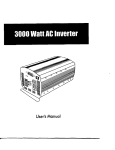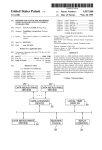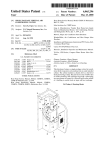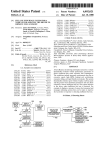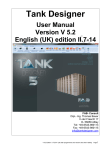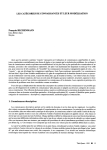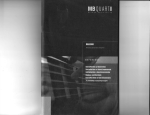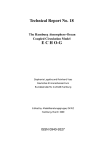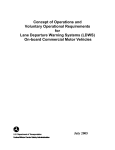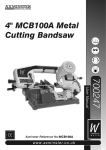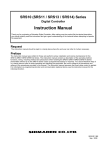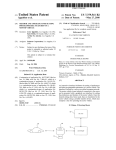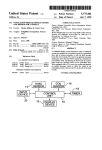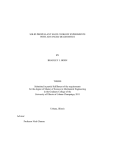Download Integrated message display system for a vehicle
Transcript
US006289332B2 (12) United States Patent (10) Patent N0.: (45) Date of Patent: Menig et al. (54) INTEGRATED MESSAGE DISPLAY SYSTEM FOR A VEHICLE (75) Inventors: Paul M. Menig, Tigard; Richard A. Bishel, Beaverton, both of OR (US); 3/1974 Sumiyoshi et al. ............... .. 340/52 F 12/1974 Hynes .............................. .. 340/52 F 3,987,439 10/1976 Spaniola 4,053,868 4,072,924 10/1977 Cox et al. 2/1978 PomerantZ Brandt, Lake OsWego, OR (US) (73) Assignee: Freightliner Corporation, Portland, OR (US) Sumida .......... .. .. 340/52 F 4,356,470 10/1982 Kogawa et al. . 340/52 F 4,400,779 4,475,380 8/1983 Kosuge et al. ..... .. 10/1984 Colovas et al. .... .. 2/1985 Grohmann et al. .. 8/1985 4,564,905 4,570,226 1/1986 Masuda et al. .. . 364/424 2/1986 Aussedat ............................ .. 364/442 364/442 . . . .. 360/5 OTHER PUBLICATIONS 154(a)(2). Sayer, First Committee Draft of SAE 12399, pp. 1—16, Sep. Subject to any disclaimer, the term of this patent is extended or adjusted under 35 CELECT R0adRelayTM—User’s Guide, Cadec Systems, Inc., Londonderry, NH, pp. 1—32, 1993. 9, 1998. (List continued on next page.) Primary Examiner—Williarn A. Cuchlinski, Jr. Assistant Examiner—Ronnie Mancho (74) Attorney, Agent, or Firm—Klarquist Sparkrnan Carnpbell Leigh & Whinston LLP (60) Provisional application No. 60/122,167, ?led on Feb. 26, (51) Int. Cl.7 ............................. .. G05D 1/00; G06F 7/00; (57) 1999. extendable, prioritized rnessage scherne. Using this scheme, the message system acts as a centralized rnessage provider for variety of alerts and operating data originating through US. Cl. ................................. .. 707/1; 701/29; 701/30; out the vehicle. The message system de?nes a hierarchy of 701/31; 701/33; 701/36; 340/435; 340/438; 340/439; 340/440; 340/441; 340/903; 180/167; 180/169; 342/69; 342/70; 342/72 message levels, each having a unique output protocol. The protocol de?nes attributes associated with messages at a particular level such as textual or graphical rnessage, an auditory alert, as Well as the scheme for playing these Field of Search .................................. .. 701/1, 29, 30, 701/31, 33, 36; 340/903, 435, 439, 440, 441, 438; 180/169, 167; 342/70, 72, 69 messages and alerts. The system integrates a variety of subsysterns that conventionally have separate driver inter faces such as a collision warning system and an adaptive References Cited cruise control system. U.S. PATENT DOCUMENTS 5/1972 ABSTRACT An integrated message system for a vehicle provides an G06F 17/00; G06F 19/00 3,665,383 ....... (List continued on next page.) Appl. No.: 09/272,878 Filed: Mar. 18, 1999 (56) Decker et al. This patent issued on a continued pros Related US. Application Data (58) 364/444 73/114 4,502,124 U.S.C. 154(b) by 0 days. (52) 9/1981 4,533,962 ecution application ?led under 37 CFR 1.53(d), and is subject to the tWenty year patent terrn provisions of 35 U.S.C. (21) (22) 340/413 340/52 F 340/52 F 5/1978 Kosuge .............................. .. 340/414 3/1981 JuhasZ et al. ...................... .. 364/424 4,287,503 Kirn; Jared A. Powell, both of Portland, OR (US); Peter Charles Notice: 3,798,596 3,852,712 4,090,194 4,258,421 Goetz Renner, Esslingen (DE); Nicolae Ghitea, J r., Tigard, OR (US); Chris US 6,289,332 B2 *Sep. 11, 2001 22 Claims, 9 Drawing Sheets Fales ................................ .. 340/52F EN GIBIIEE BRAKE CU 110 F112 5 108 FRONT f SENSOR SIDE 104 36 / 142 ANTI-LOCK COLL'S'ON ENGINE ECU WARNING/ACO SENSOR S'DE SENSOR 102 140 TRANSMISSION ECU BRAKE ECU ECU DISPLAY / 144 SHIFT I I 4150 CONTROL \ \ SWITCHES \ 130 114 DATA LOGGING/ 120% UN” / 116 US 6,289,332 B2 Page 2 McGehee, Dingus, and Horowitz, “An Experimental Field US. PATENT DOCUMENTS 4,663,718 4,706,083 4,787,039 4,845,630 5,121,112 5,148,702 5,173,856 5,189,619 5,241,295 5,303,163 5,309,139 5,327,117 5,347,260 5,432,497 5,457,439 5,463,370 5,510,776 5,525,959 5,529,139 * 5,572,428 5,572,449 5,646,612 5,648,755 5,659,304 * 5,661,658 5,678,196 5,693,876 5,731,977 5,748,477 5,757,268 5,764,139 5,771,007 5,802,545 5,839,534 6,009,355 * 6,025,789 * 6,025,796 * 5/1987 11/1987 11/1988 7/1989 6/1992 9/1992 12/1992 2/1993 8/1993 4/1994 5/1994 7/1994 9/1994 7/1995 10/1995 10/1995 4/1996 6/1996 6/1996 11/1996 11/1996 7/1997 7/1997 8/1997 8/1997 10/1997 12/1997 3/1998 5/1998 5/1998 6/1998 6/1998 9/1998 11/1998 12/1999 2/2000 2/2000 Augello et a1. .................... .. 364/444 BaatZ et a1. . 340/825.06 Murata 364/424.01 Stephens .. ... . . . . . . .. 364/442 Nakadozono 340/870.16 Gulick, Jr. .... .. 73/114 Purnell et a1. . Adachi et a1. . 364/424.04 364/426.04 Madau ............................... .. 340/461 Ebaugh et a1. ..................... .. 364/550 Austin Test of Automotive Headway Maintenance/Collision Warn ing Visual Displays,” Proceedings of the Human Factors and Ergonomics Society 38th Annual Meeting, 1994, pp. 1099—1103. Braun, Sansing, and Silver, “The Interaction of Signal Word and Color on Warning Labels: Differences in Perceived HaZard,” Proceedings of the Human Factors and Ergonom ics Society 38th Annual Meeting, 1994, pp. 831—835. “Operational Testing of Adaptive Cruise Control,” Automo tive Engineering International, Sep., 1998, pp. 63—71. ....... .. . 340/462 Clarke, Peter, “Adaptive Cruise Control is About to Take a Kohsaka .... .. . 340/525 GinZel et a1. Briski et a1. . 340/438 . 340/525 Spin,” Systems and Software, Electronic Engineering Times, Kuhn ............ .. . Ishikawa et a1. 340/435 .................. .. 340/439 Murphy et a1. ............... .. 340/825.17 PrZybyla et a1. 340/438 Kurahashi et a1. Ishida et a1. . 180/169 . 364/461 Tang et a1. .. . 364/565 Byon ..... .. . 340/903 Yagihashi ........................... .. 340/439 Chakraborty ....................... .. 340/903 Putt et al. 364/481 Katoh . . . . . . . . . . . . . Warnings: An Isoperformance Application,” Proceedings of the Human Factors and Ergonomics Society 38”1 Annual Meeting, 1994, pp. 1104—1108. Detroit Diesel—ProDriverTM—User’s Manual, Detroit Die sel Corporation, 1994. “Operating & Error Codes—Fuel—Tach DBF & DB—2 for Electronic Engines,” Series 925/205, FloScan Instrument Company, Inc. Caterpillar OWner’s Manual—Caterpillar Driver Informa tion Display, Feb. 1995. . . . .. 364/461 Nojima et a1. ..................... .. 340/461 Coverdill 1998, pp. 130—132. Appendix C, Standard Protocol, pp. 12—19. Braun, Curt C., Lori Sansing, Robert Kennedy, N. Clayton Silver,“Signal Word and Color Speci?cations for Product .... .. 73/114 . 364/426.044 Toffolo et a1. ..................... .. 340/461 Arai et a1. Engineering/Automotive Engineering International, Nov. 455/54.1 Doyle ........... .. Ghitea, Jr. et a1. Taniguchi et a1. . Oct. 26, 1998. “EVT—300 Collision Warning System & SmartCruise,” Eaton VORAD®, Speci?cation Sheet, 1998. “EVT—300 Technical Highlights,” Eaton VORAD®, Speci ?cation Sheet, Collision Warning System, 1998. “Radar—Based Adaptive Cruise Control for Trucks,” Truck . 340/903 ............................. .. 711/35 Chakraborty et a1. ............. .. 180/169 Obradovich et a1. . Lane et a1. 701/1 . 340/933 Crosby, II . 342/701 OTHER PUBLICATIONS Detroit Diesel ProDriverTM—Flyer, 1994. Appendix C, Electronic Dash Display, Feb. 2, 1996. “Joint SAE/TMC Electronic Data Interchange BetWeen Microcomputer Systems in Heavy—Duty Vehicle Applica tions,” 1988—01. * cited by examiner U.S. Patent Sep. 11, 2001 Sheet 2 0f 9 520 KEYPAD F|G- 2 DISPLAY DEVICE M MEMORYZJ1O 512 = RAM EEPROM 214 206’ S 522 \ 2Jo4 ROM US 6,289,332 B2 2oL2 ‘ ' h ‘' " > 206 CPU PORT INTERFACE $ 208-) 5 U.S. Patent Sep. 11,2001 Sheet 3 0f 9 US 6,289,332 B2 w? Pmw \ .Ewm wow Om] \ N8 \ O U.S. Patent Sep. 11,2001 Sheet 4 0f 9 US 6,289,332 B2 FIG. 5 LEVEL 1 - DANGER /5OO DANGEFI STOP ENGINE QUICKLY I10 '90s \ [S DANGER TOP ENGINE QUICKLY I10 ] FIG. 6 LEVEL 2 - WARNING 600 / WARNING . LOW OIL PRESSURE .10 /_\ / \ MESSAGE @EAQ 602 I5 604 TIME I‘ SELECTABLE 612 DRIVER DEFAULT SCREEN .1 0 ILOW OILWARNING/ J PRESSURE I10 606 628 VI \66” / ¢3%EE€2I“D ‘\ILoW OIL PREssuRE IIQI/ WARNING U.S. Patent Sep. 11,2001 Sheet 5 0f 9 US 6,289,332 B2 FIG. 7 LEVEL 3 - CAUTION 700 / CAUTION /\/ MESSAGE 702 TURN SIGNALON I10 \ REPEAT TIME z‘ 6 704 \ r 712 C [Dgli'lllggssigzgg?hfo] \ 6 71° 706 O AUTI N TURN SIGNAL ON I10 J 708 / SSECOND _\[TURN SIGNALON CAUTION I10.] / DELAY FIG. 8 LEVEL 4 - NOTE / 800 NOTE /-\ / LOW WIPER FLUID I10 \ MESSAGE REPEAT mm) / K 808 [DRIVER DEFAULT SELECTABLE] SCREEN '10 806 SSECOND J 804 DELAY NOTEFLUID n10]4 [LOW WIPER U.S. Patent Sep. 11,2001 Sheet 6 0f 9 US 6,289,332 B2 FIG. 9 FIRST STAGE DISTANCE ALERT DANGER AHEAD 90o SECOND STAGE DISTANCE ALERT DANGER AHEAD .. 902 THIRD STAGE DISTANCE ALERT DETECT LIGHT - )“2 IIIIQG / + 0094376 Ml) CREEP ALERT MOVING sLQw k 908 U.S. Patent Sep. 11,2001 Sheet 7 0f 9 US 6,289,332 B2 FIG. 10 MESSAGE 1 (Tl-PW” DISPLAY MESSAGE DATABUS MESSAGE COMMENT DANGERAAHEAD 2192266488111401CHKSUM J1587PRIORITY1 DANGERA AHEAD 219226648811 1402CHKSUM J1587 PRIORITY1 DANGER A AHEAD 21922664881 1 140 3 CHKSUM J1587 PRIORITY 1 NOAR DISPLAY R AD DETECTMESSAGE LIGHT ON 21922664881 1 140 4 CHKSUM J1587 PRIORITY 1 VEHICLE MOVING SLOW 21922664881 1 1405 CHKSUM J1587 PRIORITY 1 AAAAAAAA TAI?JLLgVILERIAN?E» 21922664881 1 1406 CHKSUM J1587 PRIORITY2 TALERT/HDWY RANGE 21922664881 1 1407 CHKSUM J1587 PRIORITY 2 TALERT/HDWY RANGE 21922664881 1 1408 CHKSUM J1587PRIOR1TY2 EI'TFTTFI MAX> < 10 11 12 cc-Trrn MAX> RAN?EX> < |al?TALERT/HDWY EEC-ZED] 21922664881 1 140 9 CHKSUM J1587PR1ORITY2 SET A-ERT/HDWY RANGE SET ALERT/HDWY RAN GE 21922664881 1 14010CHKSUM J1587 PRIORITY2 ET ALERT/HDWY RANGE 21922664881 1 14012CHKSUM J1587 PRIORITY2 <|v| N EDIE-ID] MAX> <MN IIEEIIU MAX> < N IIIIIIII! MAX> ST A_EHT D ANGE TTT'ITI'T- MAX> 14 21922664881 1 14011 CHKSUM J1587 PRIORITY2 21922664881114013CHKSUM J1587PRl0R|TY2 SETALERTVOLUME -:1:1:1:1:1:1:1 21922664881114014CHKSUM ATMINI J1587PRL0R'TY2LSED'NG INCR MENTO I\FETALERTVOLUMEIVI 21922664881114015CHKSUM SETALERTVOLUME 21922664881114816CHKSUM <M|N MAX> OF RX EE-IEEED MAX> 17 18 19 20 2‘ 22 SETALERT VOLUME <MlN 1:11-3:11 MAX> SETALERTVOLUME INCREMENT 11 REMENT 2) 21922664881 1 14817CHKSUM REMENTS) 21922664881114018CHKSUM 1:. E O REMENT 4) <M|N 1:1:1:1:-:1:1:1 MAX> SETALERTVOLUME 41 HK M INCREMENT 5) < MI N EDIE-I] MAX> 219226648811169C SU SET ALERT VOLUME 21922664881 1 14020 CHKSUM a. 1587 "U I IORLTY 2 <M|N [EDIE-3 MAX> (SETI'LNG AT INCREMENT 6) J1587P lORI 2 <1/11AFELJELEAQLIHME1AA» 21922664881114°21CHKSUM (SETTING ATIVCREMENT 71 HEADWAY DATA ONLY 23 24 MENTS 14111 DES/T111812 219 226 8 48 8 2 16 146 eee CHKSUM J1587 PRIORIT Y 2 PRIORITY2 21922664881114°23CHKSUM J1587 ACCIDENT RECONSTRUCT. CONFIRMATION SCREEN J1587PR|OR|TY2 21922664881 1 146 24 CHKSUM ACCIDENTRECONSTRUCT DATA SAVE FAILURE U.S. Patent Sep. 11,2001 Sheet 9 0f 9 US 6,289,332 B2 FIG. 12 i1204 1206 CRUISE SET TO: 55MPH 1218 HEADWAY SET TO: 30s L 1216 . WARNING RADAR CRUISE OFF RADAR HEADWAY SET LN‘ [ MIN J A202 WARNING RADAR CRUISE FAIL 1208 1210 DANGER AHEAD 1212 DANGER 1220/ SET DANGER‘ 65 AHEAD r1214 1222/ DANGER FIG. 13 DRIVER SELECTABLE 130° DEFAULT/ALERT 19G 1308 \ \ 1306 1 s04 DRIVER SELECTABLE DEFAULT/ALERT $98 1302 1308 \ 13101306 US 6,289,332 B2 1 2 INTEGRATED MESSAGE DISPLAY SYSTEM FOR A VEHICLE instrurnentation control unit determines whether to override the current message With a collision Warning alert based on the relative priority of the alert and the current message. The collision Warning alerts use a combination of visual and auditory Warnings that groW progressively more intense as RELATED APPLICATION DATA This application claims priority to co-pending US. patent application Ser. No. 60/122,167, ?led Feb. 26, 1999, the degree of danger of a collision danger increases. This entitled, “Integrated Message Display System for a Vehicle”, by Paul Menig, Richard Bishel, Nick Ghitea, Chris Kirn, Jared PoWell, and Peter C. Brandt, Which is hereby incor porated by reference. 10 adaptive cruise control messages into the systern’s central TECHNICAL FIELD The invention relates to audio-visual message displays for vehicles that provide operating, diagnostic, and Warning 15 information to the driver. iZed rnessage scheme. The instrurnentation control unit prioritiZes adaptive cruise control messages in a similar manner as collision warning messages. In particular, it determines Whether to override the current message based on the relative priority of the current message and a neW BACKGROUND adaptive cruise control message. In one implementation, for example, the instrumentation control unit manages the dis play of three types of adaptive cruise control rnessages: function set messages, system failure messages, and danger ahead messages. It generates function set messages in Over the past several years, a variety of vehicle electron ics products have been developed to assist drivers, and provide vehicle operating, trip and diagnostic information. This is particularly true in long-haul trucks, Where a number of options are available such as collision warning systems, adaptive cruise control, and Wireless communication sys terns. Sorne collision warning systems use radar to apprise the driver of collision dangers. Adaptive cruise control is an advanced feature of collision warning systems that uses approach eases the driver’s Workload because the collision alerts are integrated into the instrumentation control unit’s message center, Which provides a centraliZed source of information to the driver. Yet another aspect of the invention is the integration of response to user input, such as When the driver sets a desired headWay for the adaptive cruise control system. It generates 25 system failure messages in response to detecting a failure of radar and the vehicle’s cruise control system to maintain a some aspect of the adaptive cruise control system. Finally, it generates danger ahead messages in response to collision Warning events that occur While the vehicle is in adaptive desired folloWing distance (called “headWay”). In addition cruise control mode. to these neW electronics products, existing cornponents noW typically include electronic controls that can provide addi transmission messages into the systern’s centraliZed mes tional vehicle diagnostic and operating data. While these electronic products can provide useful infor sage scherne. The instrurnentation control unit integrates the display of transmission messages, such as the current gear Another aspect of the invention is the integration of rnation to the driver, they can also overload the driver with information. Even With careful design of displays and indi 35 cator lights for each neW feature, the driver can easily and mode of the transmission, by displaying this information along With the display of a default screen or an alert screen. become overwhelmed by the displays associated With these Further features of the invention will become apparent With reference to the folloWing detailed description and neW products. As such, the driver may ignore, or Worse, accompanying draWings. becorne distracted by the displays. BRIEF DESCRIPTION OF THE DRAWINGS SUMMARY OF THE INVENTION The invention provides an audio-visual message system for a vehicle that receives information about operating conditions from a variety of sources throughout the vehicle and generates visual and auditory outputs via a centraliZed 45 message center. The system includes an instrurnentation control unit that manages the output of alerts through a visual display and audio transducer. The instrurnentation control unit receives information about operating conditions from other electronic control units in the vehicle. In response, the instrumentation control unit determines the appropriate messages to generate based on a general, eXtend able prioritiZation scheme. The system prioritiZes alerts based on their relative impor tance. It organiZes alerts into levels of importance, Where each level has a corresponding visual and auditory alert that 55 operation of the highest priority alert, a DANGER alert. FIG. 6 illustrates the operation of the neXt highest priority alert, a WARNING alert. FIG. 7 illustrates the operation of the neXt highest priority alert, a CAUTION alert. Finally, FIG. 8 illustrates the operation of the loWest priority alert, a distinguishes it from other levels. When an event is detected that triggers an alert, the instrumentation control unit over rides a default screen and plays the corresponding alert. When more than one alert is activated, the instrumentation control unit resolves con?icts based on the priority of each alert. Another aspect of the invention is the integration of collision warning messages into the systern’s rnessage scheme. A collision warning system cornrnunicates collision Warning conditions to the instrumentation control unit. The FIG. 1 is a block diagram illustrating an implementation of electronic subsystems and their interconnection With an instrurnentation control unit. FIG. 2 is a diagram illustrating the instrumentation con trol unit in FIG. 1. FIG. 3 is a diagram illustrating a vehicle dash, and the positioning of the instrumentation control unit’s display on the dash. FIG. 4 is a diagram illustrating the keypad for the instru rnentation control unit. FIGS. 5—7 are diagrams illustrating the operation of four levels of prioritiZed rnessage displays. FIG. 5 illustrates the NOTE alert. FIG. 9 is a diagram illustrating rnessage displays of collision detection Warnings integrated into the message 65 center of the instrumentation control unit shoWn in FIGS. 1 and 3. FIG. 10 is a table illustrating a list of collision detection display messages and their corresponding priority and data bus rnessage forrnat. US 6,289,332 B2 3 4 FIG. 11 is a diagram illustrating screens in the message center for identifying the driver to the system for the purpose fuel How is directly related to the amount of time that the solenoid valve is closed. This time period determines the of maintaining a driver speci?c data record of operating events, including collision detection events. volume of fuel injected into a cylinder per revolution. By determining the amount of time that the solenoid valves are closed, the engine ECU can compute the amount of fuel FIG. 12 is a diagram illustrating screens in the message consumed by the engine. The engine ECU calculates the fuel ?oW rate from the dWell of the injection pulse and the engine center for reporting adaptive cruise control information. FIG. 13 is a diagram illustrating hoW transmission infor mation is integrated into the message center. speed. number of electronic control units (ECUs, 100—110) inter The engine ECU measures the vehicle’s road speed. A speed control senses the speed of rotation of the tail shaft of the truck and converts it into road speed. A hall effect sensor located on the tail shaft generates an analog signal com prised of a series of pulses representing the rotation rate of the engine. The engine ECU is programmed to read this digital value and derive the instantaneous speed in miles per hour. The engine ECU also monitors a variety of other vehicle connected via data links 112, 114. An instrumentation con operating parameters, including RPM, engine torque and trol unit (ICU) 100 located in the dash of the vehicle provides an integrated message center for other subsystems throttle position. These parameters are transferred to the ICU 100 over the data link 114. The transmission ECU 104 controls the trucks transmis sion. The speci?c type of ECU varies depending on the DETAILED DESCRIPTION OF THE INVENTION 10 System Implementation OvervieW FIG. 1 is a block diagram illustrating the system archi tecture of electronic control units in an implementation 15 installed in a truck. The system architecture includes a in the vehicle, including the engine ECU 102, transmission ECU 104, anti-lock brake ECU 106, and collision Warning ECU 108. In addition, the system includes a data logging transmission vendor, and the type of transmission, e.g., unit 116, Which monitors messages communicated over the data link and records operating data in response to detecting 25 events. manual, automatic or automated mechanical transmission. EXamples of transmission systems that are controlled via ECUs include the Eaton Fuller AutoShift® heavy-duty automated truck transmission and the Meritor SureShiftTM transmission system. The integrated message center of the ICU 100 in FIG. 1 includes a visual display 118 and audio transducer (i.e., a speaker) 120 for generating audio-visual alerts. The visual The transmission ECU receives driver instructions via a display includes a display screen 122 as Well as indicator driver interface in the cabin of the truck. One possible implementation of the driver interface is a column mounted shift control 150 that communicates shift command inputs to lights (e.g., 124a—c). The driver can enter input to the ICU via an input device 126 (e.g., a keypad) and, in some implementations, via discrete sWitches 128 (e.g., rocker sWitches, push buttons). SWitches and other dash controls that impact the operation of the ICU may be Wired to the a transmission ECU. For more information on this type of 35 ICU or to other ECUs, or both. For example, a collision Warning system and/or adaptive cruise control system may include input sWitches located on the dash. These sWitches can be Wired directly to the collision Warning ECU 108, Which in turn communicates input from the sWitches to the ICU. Conversely, other sWitches may be Wired directly to the ICU, Which in turn, communicates input from the sWitches Joseph LocZi, and Jason Stanford, Which is hereby incorpo rated by reference. The anti-lock brake ECU 106 controls the anti-lock brakes on the truck. EXamples of anti-lock brake systems controlled via an ECU include the WABCO ABS from to another ECU via the data link 114. The engine ECU 100 shoWn in FIG. 1, controls and monitors the operation of the engine. Like the other ECUs, the engine ECU includes a programmed data processor and memory for storing computer programs and data. The data Meritor WABCO Vehicle Control Systems, Bendix 45 The collision Warning ECU 108 controls a collision (CWS) includes a front sensor 140, side sensor 142, side and monitor engine performance. sensor display 144, and sWitches 128 (e.g., an ON/OFF The engine ECU also includes a variety of sensors and engine’s cylinders. AntiLock Systems from Allied Signal Truck Brake Systems Company, and Bosch AntiLock Brake Systems. Warning system on the truck. The collision Warning system processor eXecutes routines stored in the memory to control controls used to monitor and control the engine. One impor tant function of the engine ECU is the control of the throttle. The engine ECU controls the fuel rate by issuing control signals to a fuel injector that controls the How of fuel to the driver interface, see co-pending patent application Ser. No. 09/258,649, entitled “Lever Assembly for an Electronically Controllable Vehicle Transmission”, ?led Feb. 26, 1999, by Paul Menig, Michael von Mayenburg, Nasser Zamani, sWitch, volume control, and collision Warning range/ adaptive cruise headWay control). A programmed CPU on the CWS ECU 108 receives information about nearby objects from the front sensor 140 and side sensor 142, 55 computes collision Warning conditions, and communicates Warnings to the ICU 100. Based on information from the front sensor 140, the CWS ECU 108 measures the range, The ECU includes several sensors that monitor vehicle operating data, including a speed sensor, an RPM sensor, a distance, closing speed, and relative speed to vehicles and throttle position sensor and a cruise status sensor. Some other objects in its ?eld of vieW. For radar-controlled vehicle operating parameters are computed from measured data. For eXample, the engine torque is computed using a systems, the front sensor 140 is a radar antenna. Other types of sensors may be used as Well, such as infra-red sensors. mathematical formula that expresses engine torque as a Side sensors 142 located on the side of the truck detect function of measured parameters, including fuel rate and turbo boost pressure. The engine ECU determines the amount of fuel supplied vehicles in the driver’s blind spots. In response to detecting an object via the side sensor, the CWS generates a Warning to the cylinders in the engine by controlling the solenoid valves that inject fuel to the engine cylinders. The rate of 65 indicator on the side sensor display 144. In addition to providing collision Warnings, the CWS ECU 108 operates in conjunction With the engine ECU 102, US 6,289,332 B2 5 6 anti-lock brake ECU 106 and engine brake ECU 110 to communicated among microprocessors connected to a provide Adaptive Cruise Control (ACC). Adaptive cruise shared data link, and is speci?cally adapted for use With control is an application of the collision detection system SAE 11708. According to SAE 11708/11587, the ECUs on the data that uses data detected from the front sensor to maintain headWay (i.e., the following distance) betWeen the truck and link communicate by passing messages to each other. The the vehicle in front of it. The ACC system adjusts the vehicle’s speed from the “set speed” established for cruise ECUs can be either receivers, or receivers and transmitters. In this particular implementation, the instrumentation con trol unit 100 is both a transmitter and receiver. The engine control to maintain a safe folloWing distance from a sloWer vehicle. To control vehicle speed, the ACC system sends control messages via the 11939 data link to: 1) the engine ECU for throttle control, 2) the engine brake to actuate ECU acts as both a transmitter and receiver as Well. As a 10 speed, fuel rate, engine torque, RPM, throttle position, engine retarder braking, 3) the anti-lock brake system to initiate automatic braking, and 4) the transmission control to doWnshift the transmission. When the sloWer vehicle increases its speed or changes lanes, the ACC resumes the speed to return to the desired set speed. For more informa tion on adaptive cruise control, see US. Pat. No. 5,839,534, engine status, etc. It receives messages regarding cruise control functions. In the 11587 format, a message includes the folloWing: 1) 15 Using Standard Engine Control Modes,” Which is hereby 20 The CWS ECU 108 in the current implementation is part of the EVT-300 collision Warning system from Eaton VORAD Technologies, L.L.C. of San Diego, Calif. The ACC functionality is part of the SMARTCRUISE® adaptive cruise control system from Eaton VORAD Technologies. Other collision Warning and adaptive cruise control systems 25 30 The engine brake ECU controls engine braking by con trolling the discharge of gases from the engine’s cylinders. While shoWn as a functionally separate unit, the engine brake ECU is typically incorporated into the engine ECU. 35 The Data Links 40 applications; and 2) a data link 112 designed according to the SAE 11939 Serial Control and Communication Vehicle 45 implementations, it may also use the 11939 data link to connect the ICU With other ECUs. The 11708 data link is comprised of a tWisted pair cable operating at 9600 baud. The data link forms a communica tion channel among the electronic control units coupled to it. Electronic control units generate a digital signal on the data ers only act on a message if programmed to do so. In some cases tWo or more transmitters may attempt to broadcast a message at one time, giving rise to a collision. To resolve a con?ict among transmitters, messages have a 55 priority over lesser dominant messages. Since a loWer pri ority message is blocked by a higher priority message, the 60 transmitter of the loWer priority message must Wait and retransmit the message after another lull. An ECU on the data link Will continue to attempt to send a message until it The ECUs connected on the netWork communicate With This standard de?nes one format for data and messages priority according to their message identi?ers. The MIDs of higher priority transmitters have a greater number of bits set at a logic level one. When more than one message is broadcast at a time, the more dominant message takes vious to signal degradation. computer Systems and Heavy Duty Vehicle Applications.” particular implementation, the length of the lull is 200 milliseconds. After detecting this lull, the ECU attempts to transmit its message. The transmitter broadcasts its message onto the data link. Each of the ECUs that operate as receivers on the data link Will receive the message. HoWever, receiv sors to convey information to the ICU. For alternative each other according to protocols de?ned in SAE 11708 and SAE 11587. The SAE 11587 standard is entitled “Joint SAE/TMC Electronic Data Interchange BetWeen Micro accessing the data link and constructing messages for trans fer over it. It also de?nes a method for resource contention among the ECUs on the data link. An ECU Wishing to transmit data on the data link ?rst Waits for a lull in transmission of data on the data link. In this NetWork standard. While the current implementation prima link by applying a voltage differential betWeen the tWo Wires in the cable. A voltage differential above a speci?ed thresh old represents a logic high value, While a voltage threshold beloW a speci?ed threshold represents a logic loW value. This type of data link is particularly advantageous for hostile environments because the signal is more robust and imper character (PID). The parameter identi?ed by the PID directly folloWs the PID. The SAE 11587 supports different data formats including a single character, a double data character or more than tWo data characters representing the parameter data. Several parameters can be packed into a message, limited by the maXimum message siZe as noted above. Again, in this implementation, the ECUs communicate data links 112, 114: 1) a data link 114 designed according to rily uses the 11708 data link as a shared communication path betWeen the ICU and the other ECUs, it also uses dedicated Wiring connections directly betWeen some ECUs and sen messages. According to the SAE 11587 standard, the ?rst character of every parameter is a parameter identi?cation With each other over one of the data links 114 according to the SAE standard 11708. The standard describes methods for The implementation shoWn in FIG. 1 uses tWo separate SAE 11708, a standard for serial data communication applications. tion about one or more parameters contained Within the ADC. ADC adaptive cruise control systems include radar betWeen microcomputer systems in heavy duty vehicle standard. The message identi?cation numbers are assigned to transmitter categories as identi?ed in SAE 11587. The MID portion of a message speci?es the origin or transmitter of the message. In the majority of cases, messages are broadcast on the data link Without specifying a receiver. HoWever, the message format can be extended to include the MID of a receiver after the MID of the transmitter for special The messages passed among the ECUs convey informa may be used in the alternative. One eXample of an alterna tive system is the ADC. distance control system from based sensors and infrared based sensors. a module ID (MID), 2) one or more parameters, and 3) a checksum. The number of parameters in a message is limited by the total message length de?ned in the SAE 11708 entitled “System and Method for Intelligent Cruise Control incorporated by reference. transmitter, it sends messages to the ICU regarding road is successfully broadcast to the data link. 65 The Instrumentation Control Unit FIG. 2 is a functional block diagram illustrating the architecture of the ICU 200 shoWn in FIG. 1. The ICU has US 6,289,332 B2 7 8 a CPU 202, memory 204 and a port interface 206 for connecting the unit to the J 1708 data link 208. The memory gallons and average MPG), etc. The trip and leg keys 406, 408 are used to display the miles traveled, elapsed hours, and 204 includes programmable ROM (EEPROM) 210, RAM fuel consumed for a trip or a leg of a trip. 212 and permanent ROM 214. The routines for controlling the ICU are stored in ROM 210, While re-con?gurable data keys: The keypad also includes the folloWing general-purpose is stored in the EEPROM 214. In one speci?c implementation, the ICU has a 68HC16 1. Left ArroW Key (410) 2. DoWn ArroW Key (412) microprocessor from Motorola Corporation, and its memory con?guration 204 includes EEPROM, ROM, and RAM. This speci?c ICU has 8 KB of external EEPROM, 500K of 3. Right ArroW Key (414) 4. Set/Reset Key (416) 5. Event Key (418) 10 ROM and 64K of RAM. The internal memory of the ICU These keys can be used to scroll through message screens on the display, enter data, clear messages, etc. For example, these keys can be used to enter con?guration data such as the includes 1 Mbyte of RAM and 1 Mbyte of ROM. These speci?cations are unique to the implementation, but Will vary from one implementation to the next. A variety of microprocessors and memory systems can be used to imple ment the functionality of the instrumentation control unit. Preferably, the processor used in the ICU should have at least a 16 bit microprocessor. The speed of the processor can vary, but should be sufficient to manage the message center 15 The event key enables the driver to log an event. In response to this event, data logging unit 116 in the system persistently stores performance and ECU fault data from the data link occurring during a time period starting a predeter functions described beloW Within a 200 ms time increment. mined time before and after the event. For more information on this data logging function see US. Pat. No. 5,802,545, The ICU also includes an input device 220 and a display device 222. In the current implementation, the input device is a ten-key keypad. The display device 222 provides a textual and graphical output to the driver. The current implementation of the display device is a tWo by 20 vacuum volume object detection range for collision Warnings, and the set speed and headWay for adaptive cruise control. Which is hereby incorporated by reference. Finally, the keypad includes an acknoWledgment key 420. 25 When the ICU generates a Warning message, the driver can use the acknoWledgment key to indicate that he/she ?uorescent display. acknoWledges the Warning. The ICU responds differently to The ICU used in this implementation is manufactured by this key depending on the type and state of the Warning Joseph Pollak of Boston, Mass. for Freightliner Corporation, condition, as explained in more detail beloW. and is available as a replacement part from Freightliner Corporation. General Vehicle Operating Information and Message PrioritiZation Example of the Dash Layout FIG. 3 is a diagram illustrating the position of the ICU’s display 346 and an input device 344 among the instruments During normal operation of the truck, the ICU displays vehicle operating information, including a bar graph illus 35 and controls on a dash 322 in one implementation. The dash average fuel economy, and an odometer reading. For more 322 shoWn in FIG. 3 includes a number of gauges, including information, see US. Pat. No. 5,693,876 and co-pending for example, an analog speedometer 324 and tachometer patent application Ser. No. 08/982,117 entitled, “Fuel Use Ef?ciency System ForAVehicle For Assisting The Driver To Improve Fuel Economy,” Which are hereby incorporated by 326, a fuel gauge 328, etc. Instruments located at the dash include a parking brake sWitches 330, 332, heating, ventilation, and air conditioning (HVAC) controls 334—340, reference. The driver can directly access other information etc. In addition to these discrete gauges, instruments and indicator lights, the dash also includes the user interface for the control unit, Which is referred to as the instrument control unit in this implementation. The user interface of the instrument control unit includes a display device 342 and an input device 344, both located on the dash. via the trip, fuel, leg, and temp input keys as explained 45 These operating conditions include, for example, park The display device 346, in the current implementation, is etc. The ICU generates and controls the display of these play (LCD) or raster display device. The input device 344 of the ICU is a keypad including dedicated and general purpose function keys. Alternative implementations and con?gura 55 reaction from the driver and is used for extremely serious problems. A Level 2 Warning indicates a very serious problem and also requires immediate reaction from the driver. 1. Temperature (402) Level 3 Warnings indicate a serious problem and require 2. Fuel (404) action soon. Level 4 Warnings consist of status information and are intended to require action only When convenient. 3. Trip (Miles, hours and fuel) (406) 4. Leg (Miles, hours and fuel) (408) 402), fuel ef?ciency information 404 (e.g., fuel used in overWrite screens according to a prioritiZation scheme. In the current implementation, for example, there are four levels of alerts: Level 1 “Danger”, Level 2 “Warning”, Level 3 “Caution”, and Level 4 “Note” or “Message.” A Level 1 Warning is a message intended to evoke an immediate The keypad of FIG. 4 includes the folloWing dedicated keys: The dedicated keys are used to request speci?c informa tion such as the current outside air temperature (temperature above. In addition, the ICU displays a variety of “priority over Write” screens that override the normal operating screens When certain operating conditions are detected. brake on (While vehicle is moving), high coolant temperature, loW oil pressure, air ?lter clog, turn signal on, a tWo by 20 vacuum ?uorescent display. Alternative imple mentations are also possible such as a Liquid Crystal Dis tions of the input device are also possible. FIG. 4 is a diagram of one implementation of the keypad. The keypad includes a number of keys to enable the driver to query the ICU for information and to control its operation. trating the rate of change of fuel economy and the short term The driver can acknoWledge an alert by pressing the 65 acknoWledgement key in the keypad of the ICU. Each of the four levels of alert is associated With a predetermined message protocol, including a visual and US 6,289,332 B2 10 audio indicator. The following table provides an example of the message protocols associated with the four warning levels. When a priority overwrite message is activated, the the acknowledgement key. The repeat time of the message is a pre-determined parameter in the ICU that controls when the message center repeats the “unacknowledged” state. ICU displays a ?ashing message and emits a sequence of beeps according to the following protocols. TABLE 1 AUDITORY CODING Pause between LEVEL DANGER WARNING CAUTION NOTE MESSAGE VISUAL CODING Number Length tones Frequency ON OFF of tones (msec) (msec) of tones (msec) (msec) 7 4 2 1 1 200 200 200 300 300 14 70 140 n/a n/a 560/840 560/840 560/840 450 250 400 400 400 n/a n/a 200 350 500 n/a n/a 10 tive teXt associated with the level two condition, such as LOW OIL PRESSURE as shown in FIG. 6. 15 pre-determined delay period (e.g., 3—5 seconds), and then transitions to a second state shown in the rectangular boX 606 at the bottom of FIG. 6. The only difference between the ?rst and second states is the presence of the graphical states, including “unacknowledged” and “acknowledged.” symbol 608 indicating that the acknowledgement key is active. This symbol informs the driver that pressing the 25 the ICU emphasiZes the signi?cance of the message by ?ashing the teXt on the display and accompanying the acknowledgement key another time will remove the mes sage from the display. In response to the driver pressing the acknowledgement key 610 a second time, the message center reverts to the driver selectable default screen, as message with audible tones. When the driver presses the acknowledgment key, the message center transitions to an “acknowledged” state. A teXt message remains on the dis play until the driver has an opportunity to read and acknowl illustrated by the rectangular boX 612 on the left-hand side of FIG. 6. If the level 2 condition still persists, the message center repeats the message after a pre-determined period of time has elapsed (i.e. the repeat time). edge it a second time by pressing the acknowledge key again. The ICU is programmed so that the minimum time In response to a ?rst press of the acknowledgement key 602, the message center transitions to a ?rst “acknowl edged” state shown as a rectangular boX 604 on the right side of FIG. 6. The message center remains in this state for a A message from the ICU transitions through a series of In particular, the message center initially generates a message, the message is in an “unacknowledged” state, meaning that the ICU is seeking a con?rmation from the driver that he/she is aware of it. To get the driver’s attention, For level two conditions, the message center initially generates a ?ashing and beeping warning message as re?ected by the graphic 600 at the top of FIG. 6, and transitions to three other states before repeating. On the ?rst line of the display, the message center displays the word “WARNING” along with a symbol of the acknowledgement key. On the second line, the message center displays descrip 35 between the ?rst and second acknowledgement is long enough (e.g., 3—5 ?ve seconds) to prevent the driver from For level three conditions, the message center progresses through similar states as in level two. However, as re?ected by graphic 700 at the top of FIG. 7, the initial message is less intense in that the pause between the tones is longer. Initially, the message center displays the word “CAUTION” on the ?rst line of the display along with the symbol 702 of the acknowledgement key. On the second line of the display, the message center displays descriptive teXt associated with removing the message by pressing the acknowledgement key rapidly in succession (e.g., a quick double-click of the key). During this time, the acknowledgement key is essen tially deactivated to prevent the driver from erasing a message without reading it. When the acknowledgment key the warning condition such as “TURN SIGNAL ON.” In becomes active, the message center displays a graphical symbol to inform the driver that he/she can press the response to the driver pressing the acknowledgement key acknowledgement key to remove the message. In a case 45 704, the message center transitions to a ?rst state where the message is no longer ?ashing and beeping and the acknowl edgment symbol is no longer illuminated as shown in the rectangular boX 706 on the right side of FIG. 7. After a predetermined delay, the message center transitions to a second state where the acknowledgement key is included on the display as shown in the rectangular boX 708 at the bottom of FIG. 7. In response to the driver pressing the acknowledgement key 710 a second time, the message when the driver presses the acknowledgement key before the acknowledge symbol is displayed, the ICU emits an error beep to provide the driver with feedback indicating that he/she acknowledged the warning message too soon. FIGS. 5—8 illustrate the operation of the danger, warning, caution, and note message levels in the message center. When the message center detects a level one condition, it displays the word “DANGER” on the ?rst line of the display center transitions to a driver selectable default screen as and a teXt message associated with the danger condition on the second line of the display (e.g., STOP ENGINE QUICKLY) as shown in FIG. 5. Initially, the ICU ?ashes the 55 teXt message and generates beeping tones as re?ected by the graphic 500 at the top of FIG. 5. The graphical symbol 502 indicates to the driver that he/she can disable the ?ashing For level four conditions, the message center begins with a ?ashing message and a single beep at a lower frequency than the higher level warning messages. This initial state is and beeping by pressing the acknowledgement key 504. In response to actuation of the acknowledgment key, the mes sage center transitions to the state shown in the rectangular boX 506 at the bottom of FIG. 5. The boX re?ects that the message center is no longer ?ashing or emitting beeping auditory tones. At the danger level, the message center cycles between a ?ashing and beeping message state 500 and a non-?ashing display without beeping in response to shown by the rectangular boX 712 on the left-hand side of FIG. 7. The level 3 message will repeat after a predeter mined period of time if the condition causing the message is still active. represented by the graphic 800 at the top of FIG. 8. On the ?rst line of the message display, the message center displays the word “NOTE” and on the second line displays a teXt 65 description of the warning condition such as “LOW WIPER FLUID.” After a pre-determined delay, the message center transitions to a state 802 where the ICU adds a graphical US 6,289,332 B2 11 12 symbol of the acknowledgement key 804 to the display. In response to the driver pressing the acknowledgement key of sight (see, for eXample, the position of the display on the dash in FIG. 3). 806, the message center transitions to a driver selectable default screen as shoWn by the rectangular boX 808 on the left side of FIG. 8. The message center then repeats after a FIG. 9 is diagram illustrating an implementation of the visual indicators for the collision Warning system integrated pre-determined period of time if the Warning condition is still active. The prioritiZation scheme implemented in the ICU enables it to integrate several messages and Warning indi cators for a variety of different electronic subsystems and 10 sensors onboard the vehicle. When the manufacturer Wishes to add a neW message, it assigns it a priority level Within the into the message center. The current implementation of the message center displays ?ve different visual indicators 900—908. As the closing distance betWeen the truck and the vehicle in front of it decreases, the message center displays progressively stronger visual Warnings and generates corre sponding auditory Warnings. For eXample, the top three visual indicators 900—904 shoWn in FIG. 9 illustrate the display screen of the message center for ?rst, second and prioritiZation scheme. The ICU then determines When and hoW to display the Warning message relative to other mes Table 2 beloW gives an eXample of the type of Warning messages that are integrated into the prioritiZation scheme. third stage distance alerts from the collision Warning system. As the closing time betWeen the truck and the obstacle reaches predetermined values associated With each stage, the TABLE 2 the Words, “DANGER AHEAD.” The message center also sages based on its priority and a set of priority rules. 15 message center displays a progressively larger triangle and LEVEL 1 LEVEL 2 DANGER WARNING PARK BRAKE HIGH OFF cooLANT TEMP DANGER WARNING PARK BRAKE LoW oIL 0N PRESSURE LEvEL 3 LEvEL 4 CAUTION TURN sIGNAL 0N REcIRc MODE ENGAGED sTALE AIR IN 20 MIN. INcoMING MEssAGE teXt PRovIDE FRESH AIR sToP REcIRc displays the large triangle alert 904 in response to Warning messages associated With the detection of a stationary or sloW moving object. 25 message center displays a small triangle 906 in the default screen 910 of the message center. In other Words, the visual indicator of the detection does not overWrite the current default screen, but instead is combined With it. In the eXample shoWn in FIG. 9, the default screen displays the short term average fuel economy 912, a bar graph repre MAX A/c WARNING LoW voLTAGE CAUTION CHANGE AIR FILTER WARNING AIR FILTER cLoGGED 35 In the current implementation, the ICU is programmed to adhere to the folloWing priority rules. First, higher priorities override loWer priorities such that a danger condition has the highest priority, folloWed by Warning, caution, and ?nally note/message. When more than one monitored condition is active at a given time for messages of the same priority level, the most recent message overrides the older message. Dan ger messages that occur Within the same detection period in the ICU alternate every second. In the current implementation, the detection period is 200 milliseconds. senting changes in fuel economy 914, and the odometer reading 916. This default screen is merely one eXample of the type of normal operating condition data that may be displayed With the object detection indicator 906. In an alternative implementation, the visual indicator of a detected object may be designed to overWrite the current default screen. Another collision Warning message integrated into the message display is the creep alert (see screen 908, FIG. 9). 45 The ICU manages Warning messages that occur in the same detection period by shoWing one Warning or caution for at least ?fteen seconds and then sWitching to the second Warning or caution. Finally, the ICU displays messages that are received in the same detection period sequentially. The message center displays the creep alert screen 908 When the collision Warning system detects a object less than a predetermined distance ahead (e.g., 15 feet) and the truck is creeping (e.g., the truck speed is less than 2 MPH). In addition to integrating collision Warnings into the message center, the current implementation also integrates control sWitches for the collision Warning system into the Integration of Collision Warning System into the Message Center The ICU and its message center act as the driver interface for the collision Warning system. When the CWS detects a When the collision Warning system detects an object Within a predetermined distance (e.g., 350 feet), but this object does not represent a signi?cant threat of collision, the 55 collision Warning condition, it communicates the condition to the ICU, Which in turn, generates the appropriate message dash of the vehicle. FIG. 3 shoWs an eXample of these controls, Which include a volume control 350, an ON/OFF control 352 and range control 354. The volume control alloWs the driver to adjust the volume of auditory Warnings, While the range control alloWs the driver to control the range of the forWard object sensor. Both the volume and range controls are implemented With rocker sWitches in the current from the message center, Which typically includes a visual and an accompanying auditory Warning. According to human factors studies, auditory signals are the most domi implementation. The ON/ OFF button is implemented With a back lit push button. nant source of information to the driver. Therefore, the auditory Warnings associated With each collision Warning condition are selected to ensure that they are not confused With other sounds in the vehicle, or masked by other sounds. In addition, for quick and accurate interpretation of visual signals, the message center provides the visual Warnings associated With each Warning condition in the driver’s line 65 In addition to the visual Warnings illustrated in FIG. 9, the message center generates auditory Warnings as Well. Tables 3A and 3B beloW provide a brief summary of message protocol codings in alternative implementations of the ICU. US 6,289,332 B2 TABLE 3A TABLE 3B Auditory Coding Tone Pattern 5 P Number Tone Warning No. Description 0 side Tone Be- Fre- tween quency of Visual Tones Coding 0f Tones Length (msec) Tones (msec) 3 100 14 skt?nonary 7 200 O 2 2 sec‘. following distance 80, 80 1600 display 3 Proximity Alert 64, 64, so, 64, 64 igg, 400, 0, 800, 4 Volume Change 48 600 5 - Download Success . Accident 300, 100, 300 450, 0, 450 300 250 14 hinge/1 _ Center plus 1 Sec. Following DANGER AHEAD Distance 600 15 200 70 6 Fa?ur? 1800/ Medium ' NO Duvet ID_ 1200 triangle in ' Download Fall D. t 1S ance M ' Accident Reconstruction Creep Alarm Center plus essage DANGER Freeze Failure 25 - ID Read Fail AHEAD 3 3 Sec. 2 200 140 1800, 600 Reconstruction Freeze Con?rmation ' Built-in Self-Test 20 Following . (in HZ) 2000, right dash mang e m Message 4 Frequency of Tones . (in msec) 1 1O object ahead 2 Sec. . ' Side Sensor Alert 96, 96, 32, 96, 96 2000, 2400, O, ' ID Read Pass 2400, 2000 1 sec. following distance 80, 80, 80, 80 1800, 600, 1800, 0 16“ Slow moving 2 pause) . No. Description 1400, red LED in detection 1 (Bold = active, Non-bold = ause ' Low Voltage 1800/ Small Following Distance 1200 triangle in Message Center plus 30 DANGER _ AHEAD _ _ _ _ Table 4 provides a more detailed description of an inte gration of features of the collision warning system into the message center (M.C.) and dash display. TABLE 4 Integrated Format Display Feature Auditory Visual Control/Sensing Unit Power-On Drivers Card Status None light on switch illuminates when system is on (M.C. NOTE if card Rocker switch Volume Control 1 short tone for each change increment (at the new M.C. display Rocker switch (default setting = 3A RADAR VOL 75% maximum volume) is not inserted) volume level) (displayed for 7 seconds after each change) Speaker Range all auditory output 1 short tone for each V10 control/accident second change in range recorder setting n/a M.C. display: MAX RADAR RANGE 2.5 SECONDS adjusted by volume control Rocker switch dash or steering wheel (default setting at maXimum range) (gives current maXimum range setting based on following System failure Adjustments in distance) M.C. tones for warning TELLTALE: RADAR FAIL (red) operation) n/a n/a Message Center is automatically 110116 very small triangle on default object detected within 350 feet Lighting Vehicle detection System check sensor (performed every 15 seconds during normal M.C. message: WARNING RADAR SYSTEM FAILURE dimmed screen of MC. and/or detect indicator light 1“ stage See tone No. 3, Table 3A DANGER AHEAD 3 second sensor small triangle distance alert (?gure below) 2nd stage See tone No. 2, Table 3A DANGER AHEAD 2 second sensor medium triangle distance alert (?gure below) 3Id stage See tone No. 1, Table 3A DANGER AHEAD 1 second sensor US 6,289,332 B2 15 16 TABLE 4-continued Integrated Format Display Feature Auditory Visual distance alert Control/Sensing Unit large triangle (?gure below) Stationary object See tone No. 1, Table 3A Slow moving object See tone No. 1, Table 3A Creep alarm See tone No. 2, Table 3A No vehicle detected none DANGER AHEAD Should be set for a distance large triangle (?gure below) appropriate to speed of vehicle (to reduce false alarms) DANGER AHEAD Should be set for a distance large triangle (?gure below) CREEP ALERT appropriate to speed of vehicle (to reduce false alarms) Vehicle speed <2 mph & object less row of small triangles than 15 feet ahead (?gure below) yellow light on dash display Stays on when no vehicle is detected red light on dash display by the blind spot sensor Activated when objects are detected by the blind spot sensor in blind spot Vehicle detected in See tone No. 0, Table 3A blind spot As explained above, the message center integrates mes sages from a variety of different vehicle systems using a prioritization scheme. It also uses a prioritization scheme to TABLE 5-continued 25 Overview of Priority Assignments and Auditory Signals for Message Center integrate the messages from the collision warning system. In the current implementation, the priority rules for integrating collision warning messages are as follows. The warning messages for a stationary object, slow moving object, and the shortest monitored following distance (one second) are assigned the highest priority and override level 1 danger Prior- Number ity Warning Level Description alerts. As such, the immediate external threat takes prece dence over in-vehicle dangers. The level 1 danger alerts have the next highest priority and override collision warning alerts for following distances of two and three seconds and the creep alarm. The rationale for ranking level 1 danger Pause Between Fre quency of Tones Length (msec) Tones (msec) of Tones 4 200 70 1800/ DANGER 3 2 Sec. Following Distance Creep Alarm 1200 4 3 Sec. Following Distance 2 200 140 1800/ 5 Message Center: 4 200 70 560/840 2 200 140 560/840 1 300 n/a 450 3 100 14 2400, 2000, 1600 1 300 n/a 250 1200 alerts ahead of these collision alerts is that severe in-vehicle WARNING dangers take precedence over less immediate external threats. Level two warning messages and level three caution messages may override collision warnings for two and three second following distances if those collision warnings have been displayed for at least ?fteen seconds. The rationale is that the driver has most probably chosen a particular dis NOTE/MESSAGE inde- Side Object Detection (may pen- be given with any other dent warning) tance to the vehicle ahead and intends not to change the following distance. In this case, the driver is aware of the press not available” or 6 Message Center: CAUTION 7 Message Center: level Message Center: “Key situation and a level two or level three message override the “improper use” tone collision warning conditions. A summary of the priority assignments for the message center and collision detection warnings is provided below in Table 5. Note that Table 5 represents only an example of one 50 possible implementation. Alternative codings are possible, such as the auditory codings shown in Table 3B. TABLE 5 55 Overview of Priority Assignments and Auditory Signals for Message Center Prior- Number ity Warning Level Description 1 Stationary Object 2 1 Sec. Following Distance Message Center: Fre quency of Tones Length (msec) Tones (msec) of Tones 7 200 14 1800/ 60 mind that these details are not necessary for implementation range. In general, auditory warnings should be prioritized 65 200 14 560/840 details, it is possible to deviate from these speci?cations without departing from the scope of the invention. Anumber of additional design details are worth noting, keeping in of the invention. First, the auditory signal should be at least ten dB above in-cab sound level in the particular frequency 1200 7 sages in the J 1587 protocol. The J 1587 protocol implements a priority scheme for controlling which messages take precedence when transmitted concurrently on the data link. While the above table provides speci?c implementation Pause Between Slow Moving Object The priority level speci?ed in the Table refers to the priority of a message from the perspective of the ICU. In particular, the ICU is programmed to arbitrate among mes sages of different priority according to these levels. This priority level scheme is separate from the priority of mes based on the number of tones and the pauses between the tones. In particular, the greater the number of tones (e.g., 1, 2, 4, 7) and the shorter the pauses between the tones (e.g., US 6,289,332 B2 17 18 14 msec., 70 msec., 140 msec.), the higher the priority. Preferably, the auditory tones for collision Warnings should be distinguishable from the auditory tones used for other Bits 3—1=000 (Priority 0) 2=Message roW/line number (second line of display) 16=Message column number (16th column) messages in the message center. In the current implementation, the non-collision Warnings have a notice 140=Proprietary message (de?ned as the MID of the ably loWer frequency (e.g., 560—840 HZ) than the collision detection Warnings (e.g., 1200—1800 HZ). In addition, to e e e=Proprietary message (de?ned as the ASCII value for alloW the driver to better distinguish betWeen different types of Warnings, the message center Warnings use a repeating tone sequence of loW to high, While the collision Warning device that has the display; MID 140=ICU) the headWay, eX. 3.0). 10 ICU folloWs a set of predetermined guidelines. For each message in the table of FIG. 10, the message center displays 15 speaker directly to generate auditory Warnings. In alternative implementations, the CWS ECU could communicate mes sages for both auditory and visual Warnings over the data link using the 11587 standard, via discrete Wiring, or some combination of both. the corresponding message for a predetermined period of time, namely 1.0 second. To display the message a longer period of time, the CWS ECU sends the same message again after 0.5 seconds, and continues re-sending at this rate. Upon receiving a data bus message, the ICU sets a timer to 1.0 20 To communicate instructions for visual Warnings, the CWS ECU broadcasts data bus messages over the 11708 data link. FIG. 10 illustrates a table listing the display message and the corresponding data bus message used to instruct the ICU to display it. The messages are listed in order of priority. If the ICU receives a message With higher diX C of the 11587 standard. In managing the output of collision Warning messages, the tones use a tone sequence from high to loW. In the current implementation, the CWS ECU communi cates visual messages to the ICU via the 11708 data bus according to the 11587 communication protocol. The CWS ECU is Wired to the speaker of the ICU and drives the For more information on the message format, see Appen 25 second, and continues to display the message as long as the timer has not elapsed. The ICU resets the timer (to a full 0.75 seconds) upon receiving a neW message. This approach for re-sending messages and re-setting the timer With each neW message ensures that the delay betWeen transmissions of messages Will not produce a ?icker in the ICU display. Another feature relating to the integration of collision message transmission on the 11587 data link. The internal Warnings into the message center is the ability to select a driver for the purpose of logging events on a per driver basis. The ICU provides a display that enables the driver to enter a driver identi?cation (ID), and is programmed to broadcast a message on the data bus including the driver ID. The CWS ECU and other ECUs are programmed to store the driver ID and record it along With events that they monitor. In priority controlled Within the ICU is re?ected by the order ing of the messages in the left-most column. The 11587 message priority is noted in the right-most column. particular, the current implementation of the ICU broadcasts the driver ID in PID 507 of the 11587 protocol, in response to a request from another ECU (e.g., the CWS ECU) using Message 22 in the table shoWn in FIG. 10 is the data required to display the folloWing teXt message on the MID 219. In the current implementation, the ICU prompts the driver priority than the one it is currently displaying, it displays the higher priority message as soon as it receives the message 30 from the data bus. As noted above, the priority scheme implemented in the ICU is different than the priority of message center: Cruise Set to: XXMPH HeadWay Set to: eeeis Where eee is the headWay data in ASCII characters, example: 3.0, to be used in data bus message 219 226 40 or to select a neW one. FIG. 11 illustrates an eXample of the message center displays 1100, 1102 used to prompt the 45 8 48 8 2 16 140 e e e chksum. screen, or select a neW driver by pressing an arroW key as shoWn. After the driver presses the acknoWledgement key at 219 226 8 48 8 2 16 140 e e e chksum. 226=PID (Text Message to Display) 8=Number of bytes folloWing 48=Status Character 1 (48 decimal=00110000 binary) Bit 8=0 (Use selected language) Bit 7=0 (Message OK) Bit 6=0 (Prede?ned teXt) Bit 5=1 (Display buffered message) driver for the ID. The driver can either select the active driver ID by pressing the set key in response to the ?rst FolloWing is a description of data bus message 22 (it applies to other messages as Well): 219=MID (CWS ECU) to enter the driver ID during the ignition sequence. During the ignition sequence, the message center displays screens that prompt the driver to accept the currently active driver ID 50 either screen 1100, 1102, the message center continues With the ignition sequence as shoWn in the third screen 1104 in FIG. 11. In response to the selection of the driver ID, the ICU sends a PID 507 message, Driver Identi?cation, over the SAE 55 1 1708/ 1587 data link to indicate What driver is active (Driver 1 or Driver 2) as soon as the driver acknoWledges the ICU screen prompt, per the folloWing message formats: Bit 4=0 (No sound; sound is controlled by the EVT-300 directly) 60 Bit 3=0 (No acknoWledgement) Driver 1 Bit 2=0 (Do not eXpect acknoWledgement from MID PID n ASCII 140 507 2 49 42 (1) (*) operator) Bit 1=0 (Do not send acknoWledgement) 8=Status Character 2 (8 decimal=00001000 binary) Bits 8—4=00001 (de?ned as 1 Second; actually is less than 1 second) ASCII Cksurn Note that PID 507 is sent as tWo consecutive bytes: 255 folloWed by 251.


























